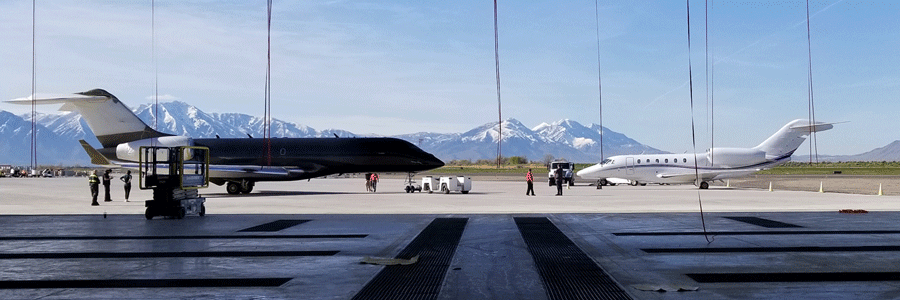Best Advice For First-Time Business Jet Buyers? Don’t Skip The Pre-Purchase Evaluation
December 2024

Buying a business jet, especially for the first time, is a significant investment with many factors to consider. One of the most critical steps in this process is conducting a PPE (pre-purchase evaluation). For first-time buyers, this evaluation may seem like a complex and time-consuming process, but it’s designed to protect the investment and ensure that buyers are making safe, well-informed decisions.
What is a Pre-Purchase Evaluation?
A PPE is a thorough, non-biased evaluation of a pre-owned aircraft that includes multiple checks on its airworthiness, mechanical condition, maintenance history, regulatory compliance, and overall safety. This process involves various participants, including aircraft brokers or acquisition representatives, technical representatives with expertise in the specific airframe, engine, cockpit, and cabin technology, and associated components of the specific aircraft being evaluated.
Top Six Reasons Pre-Purchase Evaluations Are Essential And The Risks They Can Help Avoid
- Determines if the aircraft is in delivery condition. The goal of all PPEs is to verify that the aircraft is in the delivery condition agreed upon by the buyer and seller in the APA, or Aircraft Purchase Agreement. In addition to the delivery condition, the scope of the PPE should be clearly outlined in the APA.
- Identifies potential mechanical issues and uncovers hidden costs. Experienced airframe and engine technicians can identify potential issues not listed in the aircraft’s spec sheet. Discovering any hidden or upcoming repairs upfront can save buyers from unexpected expenses after the purchase.
- Verifies maintenance history and confirms value. Reviewing the aircraft’s maintenance history ensures that its condition aligns with expected standards. It can also reveal any previous repairs, damage history, or overlooked issues that may affect the aircraft's true value or upcoming major inspections or mandated upgrades that may be required but were not previously disclosed.
- Empowers negotiation. A PPE provides buyers with a powerful negotiation tool. Identifying discrepancies that deviate from the agreed-upon delivery condition gives the buyer leverage to negotiate for repairs or price adjustments based on the aircraft’s current condition.
- Ensures compliance with regulations. A PPE verifies that the aircraft meets regulatory requirements, protecting the buyer from potential FAA complications or limitations. This is particularly important for cross-border transactions that require an aircraft to be certified under a different country’s airworthiness regulations, which could result in lengthy delays or unanticipated expenses.
- Mitigates long-term financial risks. By understanding the aircraft’s current condition and upcoming maintenance needs, buyers can better plan future budgets, prevent costly surprises, and avoid unforeseen downtimes.
Consequences of Skipping the Pre-Purchase Evaluation
During the post-pandemic aviation boom, many first-time, uninformed, and poorly advised buyers rushed into aircraft purchases without conducting a PPE. Due to unexpected expensive surprises, many are now faced with selling these investments at a significant loss.
Here are some issues that can arise if you skip this critical step:
- Supply chain delays: Unanticipated maintenance events due in the next 12-24 months can lead to significant delays, particularly if replacement parts are not readily available.
- Component obsolescence: Older jets often have outdated components that may require costly replacements or upgrades.
- Mandated upgrades: Unexpected upgrades can be very costly and lead to extended downtimes.
But I know the buyer. I don’t need a PPE!
When the buyer and seller know each other, a full-fledged PPE might not be needed. However, it’s a decision that should not be made lightly.
As the buyer, DO NOT make assumptions about the condition and value of the aircraft based solely on the relationship with the seller. Those assumptions often prove to be incorrect and can lead to damaged relationships. Even well-meaning sellers may not be fully aware of technical details or hidden issues. A PPE conducted by a team of experts can protect both parties and prevent potential damage to personal or professional relationships.
For the first-time business jet buyer, a PPE is an indispensable step that ensures the aircraft is a sound investment and helps the buyer budget and plan for future maintenance.
Duncan Aviation’s Aircraft Sales & Acquisitions
Duncan Aviation has a team of market researchers, data analysts, import/export specialists, marketing experts, modification and engineering representatives, and the industry’s most experienced airframe/engine/component technical representatives. They have sophisticated subscription-based programs, model comparison programs, internal data, and other resources, including:
- Detailed data and market conditions of on-and off-market aircraft options
- Comprehensive aircraft model comparisons to aid in selecting the right aircraft for the mission
- Proprietary budget projections for upcoming maintenance events derived from years of out-the-door costs for inspection programs on a wide range of models
- Evaluation of aircraft systems for issues related to obsolescence
- Inspection status and component cycle evaluation
- ROM pricing for upcoming inspections, desired modifications/upgrades, or cosmetic improvements on specific serial numbers.
To learn more about the services offered by Duncan Aviation’s Aircraft Sales & Acquisitions Department. Contact us at aircraftsales@duncanaviation.com.
Additional Resources
View Available Duncan Aviation Aircraft Listings
Read Aircraft Sales & Acquisitions Brochure
Business Jet Model/Market Summary
